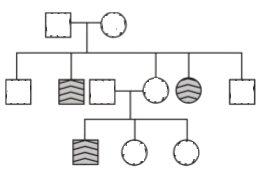The ultimate source of allelic variation is:
(1) Recombination
(2) Natural selection
(3) Mutation
(4) Drift
In the case of co-dominance, the F1 generation resembles:
(1) Dominant parent
(2) Recessive parent
(3) Both the parents
(4) None of the parents
What can be the possible blood groups of progeny whose father and mother are of A and B group respectively?
(1) A and B only
(2) AB only
(3) All except O
(4) A, B, AB and O
In case of starch synthesis in pea seeds [controlled by B gene], BB homozygotes produce large and round starch grains; bb homozygotes produce smaller and wrinkled starch grains and Heterozygotes produce round seeds of intermediate size. What can be inferred from this observation?
(1) The gene B mutates at a faster rate.
(2) The gene B is easily influenced by the environment
(3) Dominance is not an autonomous feature of a gene or the product that it has information for
(4) Some genes do not follow the law of segregation.
"When two pairs of traits are combined in a hybrid, segregation of one pair of characters is independent of the other pair of characters". This is the statement of:
(1) Law of Dominance
(2) law of segregation
(3) Law of Independent Assortment
(4) Law of Linkage
A test cross is done to find out
(1) Fitness of an organism
(2) Genotype of a plant expressing dominant phenotype
(3) The suitable parents for a Mendelian Cross
(4) The hidden genotypic ratio of F2 phenotypes
In a monohybrid cross F1 progeny resemble neither of the parents. What would be true in this case?
1. The parental traits would not appear in any of the F2 -progenies
2. The F2 phenotypic ratio will be different from the F2 genotypic ratio
3. It could be a case of incomplete donminance
4. The F2 genotypic ratio will be similar to any Mendelian monohybrid cross
The two alleles of a gene pair are located on:
1. Homologous sites on homologous chromosomes
2. Heterologous sites on homologous chromosomes
3. Homologous sites on heterologous chromosomes
4. Heterologous sites on heretologous chromosomes
Male heterogamety is not seen in:
(1) Humans
(2) Melandrium album
(3) Birds
(4) Fruit fly
The trait shown in the given pedigree chart is most likely a/an:

1. Autosomal recessive trait
2. Autosomal dominant trait
3. Sex linked recessive trait
4. Sex linked dominant trait






